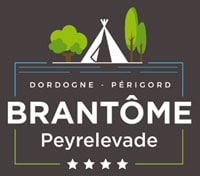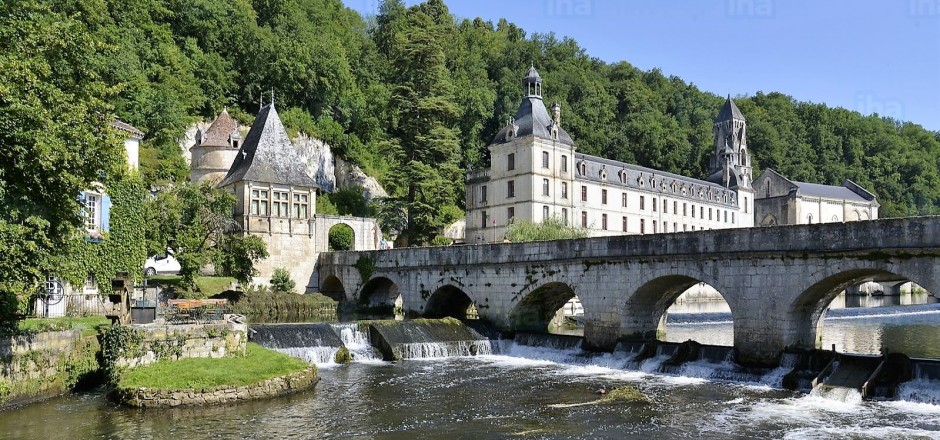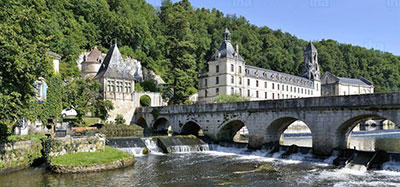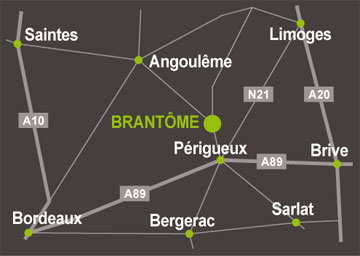Brantôme,
The venice of the Périgord
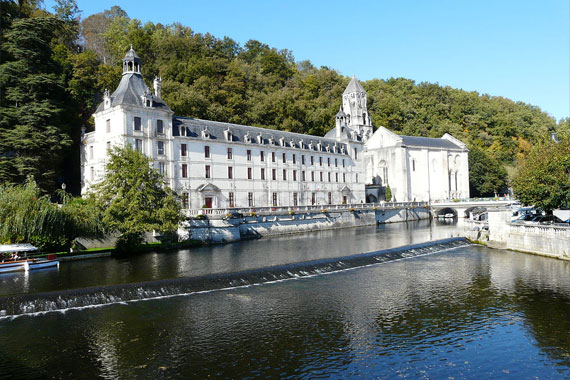
In the Dordogne, in the heart of the Périgord Vert, go and explore the medieval town of Brantôme.
Encircled by the river Dronne, Brantôme is an island where you will discover a Benedictine abbey with its cloister founded in 769, a church dating back to 1516, the oldest bell tower in France and, of course, streets where you can lose yourselves and further discover this jewel of the Périgord.
Food lovers shouldn’t miss the local farmers’ markets: every Friday morning and Tuesdays (in July and August).
There are a number of shops to make your stay at the campsite easier.
While you are strolling through the streets of Brantôme, go and visit our local artisans – glass blowers, cutlers, ice-cream makers and delicatessens.
Find out more...
There are so many things to see in Brantôme!
The remains of the Benedictine monastery in Brantôme (8th century) dug into the limestone cliff, the mysterious ‘Last Judgement’ cave and its monumental bas reliefs.
The Saint-Pierre de Brantôme abbey
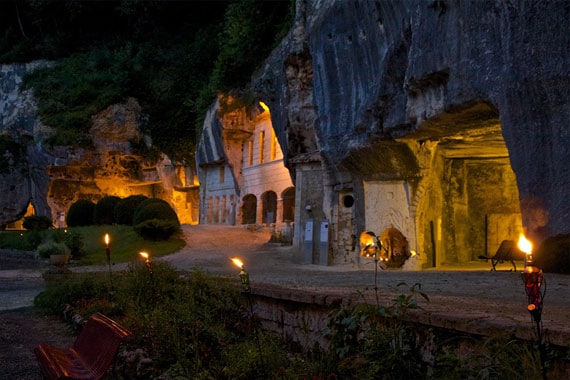
Founded in 769 by Charlemagne, the abbey in Brantôme en Périgord was designated a historical monument in 1840. Situated at the foot of the cliff, according to tradition the abbey was consecrated by Charlemagne himself. There is a magnificent view over the town from the bell tower.
As you lose yourself in the streets of Brantôme en Périgord, you will often come across artisans’ shops. Go in and visit their world:
Eric Simonin, glass blower
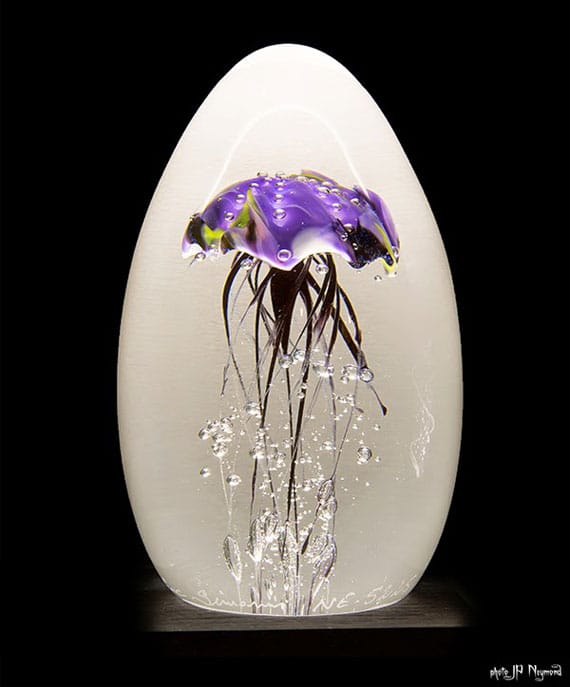
His universe is nature. Eric Simonin transforms sand into mushrooms, jellyfish and butterflies. This glass craftsman pays tribute to nature, its beauty but also its fragility. He wants to raise our awareness and encourage us to have a different perspective on the diversity we no longer see and yet which makes up our world.
His workshop is located in one of the many caves at the foot of the Brantôme cliff – an ideal place where the glass is exhibited against a mineral backdrop.
François Devigne, cutler
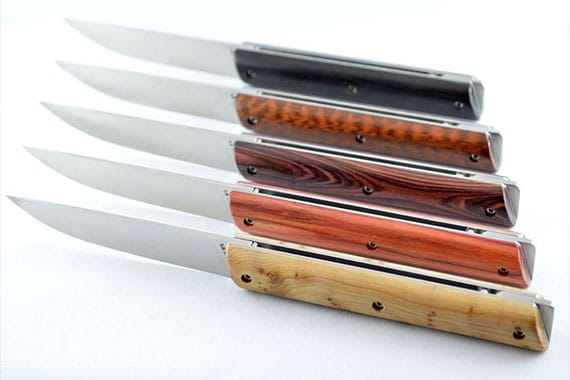
The Dordogne has a long history of cutlery-making and one of its representatives, situated in the heart of the village, showcases all of his expertise.
François Devigne is behind the creation of the ‘Le Périgord’ knife. He transforms wood and steel into magnificent everyday companions, always looking for innovation; you will be amazed by his most recent creation, ‘Le Constellation’.
The ice-cream man of Brantôme
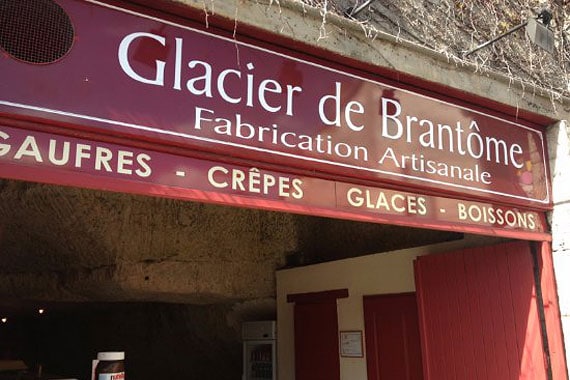
Craftsmanship can be tasty! You’ll realise this when you push open the door of Pierre Pares’ shop and discover his 51 artisanal ice cream flavours. From traditional flavours to the most suprising ones: try the foie gras ice cream! You will always find the perfect flavour to cool off in the Périgord sunshine.
La Maison Carteaud
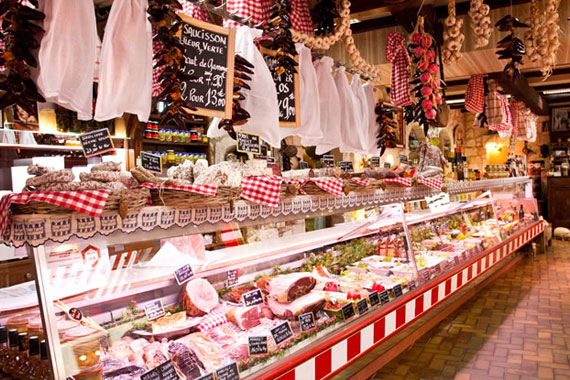
Situated in the heart of Brantôme, La Maison Carteaud has been offering traditional, high-quality cuisine since 1932. You can choose between its fresh cooked produce, its preserves as well as its many regional products. Whether it’s to eat at the campsite or take back home as a souvenir, food lovers will find everything they are looking for.
The Truffle Ecomuseum
You can’t come camping in the Dordogne-Périgord without discovering our black diamond: the truffle. And the perfect place for this is the ecomuseum in Sorges, a few kilometres from the campsite. All of the mysteries of this mushroom – both scientific and gastronomic – will be revealed. In the museum shop, you can buy truffle in every shape and form: oil, salts, honey and, of course, the famous Périgueux sauce.
Truffle tasting on-site all year round.
The prettiest villages in France
If you find yourself in the Dordogne, it’s also because you have heard about its villages and castles. The Périgord Vert is no exception to the rule, as it offers you the opportunity to travel through time in the area around the Le Peyrelevade campsite.
In the immediate vicinity of Brantôme, we invite you to take a stroll through villages and eras.
From the Middle Ages to today
Even if many of our villages are centred around a castle, an abbey or a covered market, the charm of the old stones will surprise you every time. Bourdeilles with its mill and castle, Villars and its cave, Saint-Jean de Côle and its Byzantine church, Périgueux and its five-domed cathedral…are all outings you can go on as a couple or as a family, in search of the authentic Périgord.
The Gallo-Roman period
The town of Périgueux, capital of the Périgord, is like an open-air Gallo-Roman museum. Indeed, if you walk around the streets of the town you will discover the Vésone tower or its amphitheatre. The Vesunna museum will add the finishing touch to your visit.
Find out more...
Bourdeilles
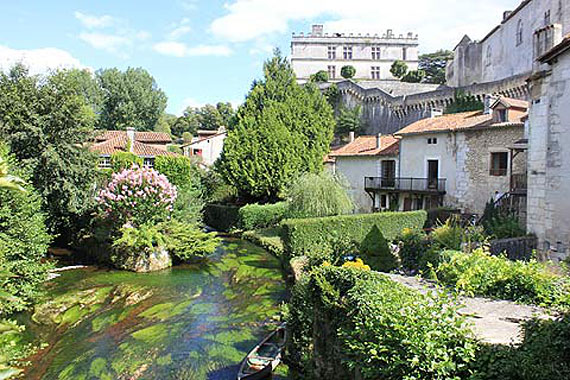
A designated historical monument, the castle of Bourdeilles – built around a medieval fortress – will enchant lovers of history and art. Two castles from different eras (medieval and Renaissance), built on a rocky terrace raised by a rampart overhanging the river Dronne. The first is a feudal fortress (13th-14th century), which is dominated by a unique 35m high octagonal keep. The second is a Renaissance dwelling (16th century), with richly decorated formal rooms and which houses a prestigious collection of furniture (in particular Charles Quint’s bed).
Villars
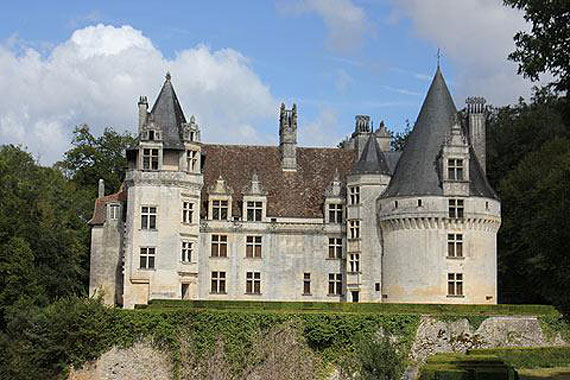
The Château de Puyguilhem, a designated historical monument from the early Renaissance period, is worthy of the most beautiful Loire valley residences from the time of François I.
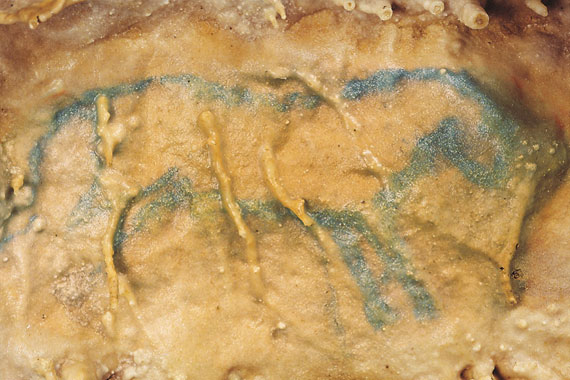
The Villars cave is small, yet it contains absolutely everything you will find in the large caves of the Périgord Noir. There are also the remains of the Cistercian Boschaud abbey, built between 1154 and 1159, and whose construction had benefited from the generosity of nearby Pérouse abbey. Its architecture is exciting, combining the major principles of Cistercian architecture and a style typical of the Périgord (a skilful construction including a series of domes resting on pendentives). Rediscovered during the 19th century, it is a place that gives off enormous spirituality.
Saint-Jean de Cole
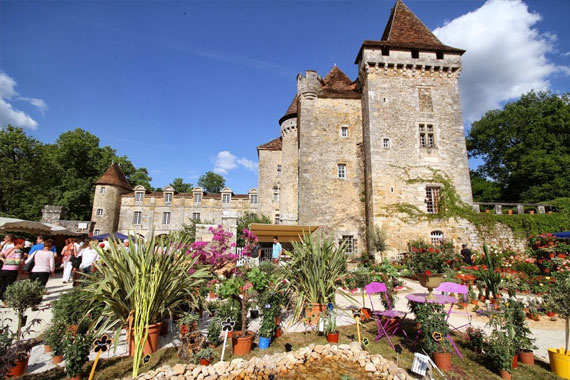
Designated one of the most beautiful villages in France, with a backdrop of greenery, history, tranquility and serenity, set among green hils and on the banks of the river Côle – it is an astonishing architectural ensemble. Saint Jean de Côle is proud of its 11th-century Byzantine church, the Château de la Marthonie, its cloisters, its stone bridges, its main square surrounded by half-timbered buildings, its covered market hall and its houses and their picturesque roofs. In May, it welcomes a renowned flower exhibition and, during the summer months, music concerts are organised in the 12th-century church. It is a wonderful place to visit.
Périgueux
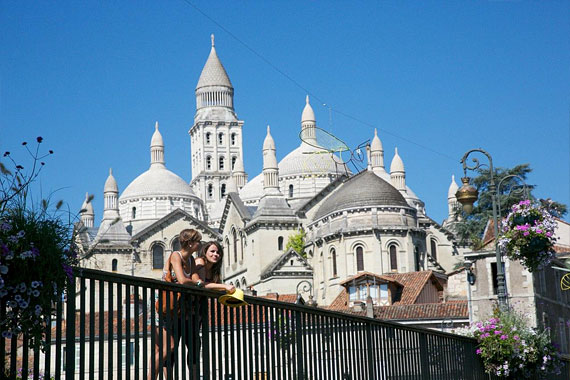
Explore the paved and shaded streets of the old part of Périgueux until you reach the majestic St Front cathedral – you will discover a lively town full of history, as it was founded back in the 1st century. During the summer there are a number of festivals, including the international mime festival Mimos, which brings together thousands of people each year, and the famous ‘night of the stars’ where the whole family can discover the starry sky. Whilst you are in Périgueux, visit the Vesunna museum and discover the Gallo-Roman world.
Caves
The Dordogne – also called the ‘cradle of mankind’ – has a long history and above all evidence of ancestors from over 400,000 years ago. There are many caves to be found in the vicinity of your campsite rental.
Enjoy its many caves during your camping holidays in the Dordogne – they are a testament to ancient times when man painted the cave walls and discovered fire. This is an opportunity to look back in time and discover the life of our great ancestors.
The closest cave is the Villars cave

Its famous blue horse is one of the few prehistoric paintings to have survived until now, and you will be amazed by the subtle delicateness of its natural decor. A park at the entrance to the cave lets you discover the habitat and daily lives of our ancestors during the Stone Age.
Find out more...
The Villars cave
Just a few kilometres from our 3-star campsite in the Dordogne, you will find the only cave in the Périgord with original prehistoric paintings and natural concretions.
The Villars cave is one of the Périgord’s largest underground networks, and almost 13km have been explored to date. The underground river has dug enormous rooms linked together by tunnels. The infiltration waters have created a fantastic natural setting. The prehistoric paintings were discovered in 1958. They are a genuine testament to the art of our ancestors.
A number of horses are represented, but you can also see ibex, bison and one of the very few human representations of prehistoric art.
The most recent discovery is the Tourtoirac cave
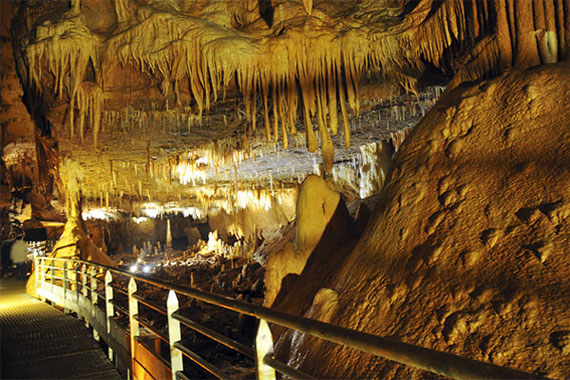
A ceiling of mineral lacework and vast tunnels following the underground river – you will marvel at these beauties sculpted by nature. An exceptional sight.
Find out more...
The Tourtoirac cave
We invite you on a journey in the Périgord that goes back 30,000 years; when it was discovered recently (in 1995), the Tourtoirac cave enthralled first its discoverer and then his speleologist friends. Over time, water and nature have hollowed out the cavity and embellished and designed it into a vast fresco.
As you follow the underground river, you will be immersed in a show of shadows and lights between columns and eccentric and fistulous draperies.
This unforgettable journey to Tourtoirac will also enable you to discover this village marked first of all by prehistoric times, then the history of an ancient abbey.
The most famous cave: Lascaux 4

An identical reproduction of the famous Lascaux cave has been open to the public since 2017. We now have the opportunity to visit this gallery and its paintings in the same conditions as the four children who – thanks to their dog – discovered the cave. The experience continues with digital workshops and a breathtaking 3D cinema. Pre-booking is of course required during the summer.
Find out more...
The Lascaux 4 cave
The most famous of the Périgord caves was reproduced identically in its entirety in 2017. You can now visit the original cave in its entirety, but also enjoy digital workshops for an even more intense experience.
Castles, Mills and Gardens
According to legend, the Dordogne is strewn with thousands of castles and gardens – and this can’t be far off the reality. The first edifices date back to the 12th century and each have their own personalities – you’ll be spoilt for choice!
They are easily found as they are often perched on promontories, guaranteeing you memorable views over the surrounding landscapes. Come and see the Dordogne from above.
The castles and mills of the Dordogne
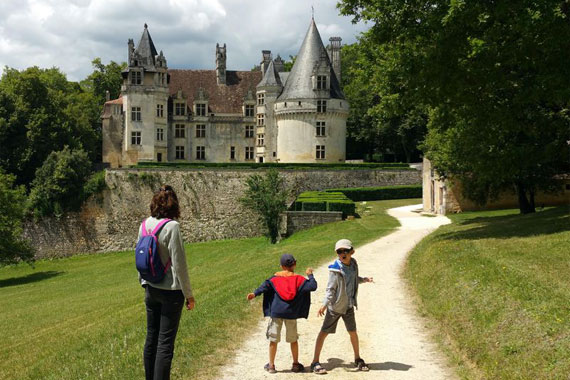
Day and night, there is always a castle just asking to be visited. Some of them will offer treasure hunts and others fireworks or night-time visits by candlelight. Here we suggest a small sample of these majestic fortifications, with the residence of the Marquis de Jumilhac, the stately Château de Hautefort, and the elegant Château de Puyguilhem.
Would you like to see some others? Come to the campsite reception, we will guide you through the Dordogne.
Find out more...
Château de Jumilhac
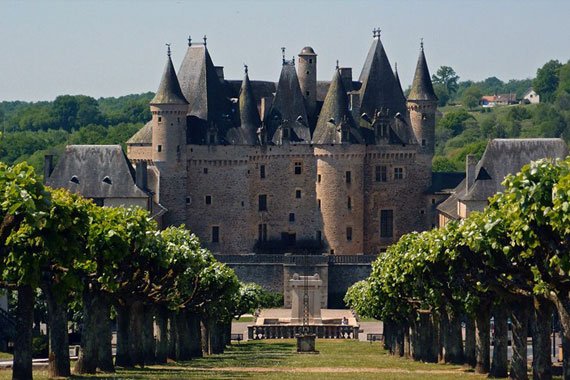
In the heart of the Dordogne, travel through time as you visit this splendid edifice, built between the 13th and 17th century, as well as its gold and alchemy-themed gardens.
You will learn about the history of the castle and its family through the centuries.
The castle is a designated historical monument and remains a private castle, belonging to the same family since the 16th centruy: the Marquis de Jumilhac.
Château de Hautefort
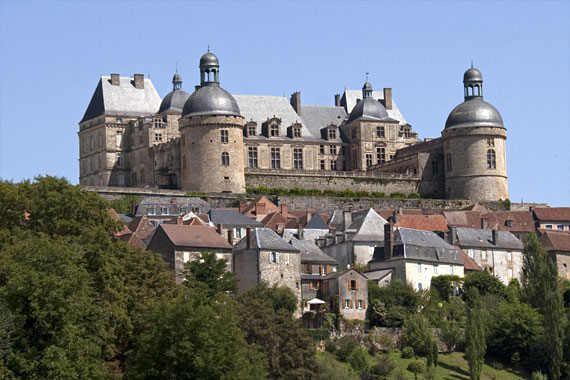
This magnificent castle is a designated historical monument, and is one of these castles whose view sweeps across the whole valley since it is built on a rocky spur dominating the commune and village of Hautefort. Built over a period going from the late 16th century to the late 17th century on the foundations of a former fortified castle, its architecture clearly brings to mind the castles of the Loire. It is one of the few examples of classical buildings in the Dordogne.
Château de Puyguilhem

A splendid testament to the Renaissance period, this castle has been an example of French elegance since 1510. Twenty years of work were required to save it from ruin. An unmissable visit in the Périgord Vert.
Moulin de Lapeyre

This old mill, which has been completely restored, is located in Saint Estèphe in the Dordogne, a charming village in the heart of the Périgord Vert that is reviving our cutler traditions.
After several years of renovation that were needed in order to give a new lease of life to the two wheels that keep the mill running and the forge, the cutlers will be delighted to show you how the knives are made, together with a exhibition of 3,000 tools and the production of walnut oil.
The gardens of the Périgord
The Périgord Vert gets its name from its forests and its vegetation, which are always green whatever the season- not forgetting the many gardens that are part of the dominant green colour of this part of the Dordogne.
These oases of calm – a true feast for the eyes – are sculpted by their owners in order to offer you a moment of tranquillity and beauty.
So do visit the ‘Jardins Tranquilles’ of Brantôme, the panoramic gardens of Limeuil and those of Eyrignac, which are a pleasure to see.
Find out more...
Les Jardins Tranquilles in Brantôme
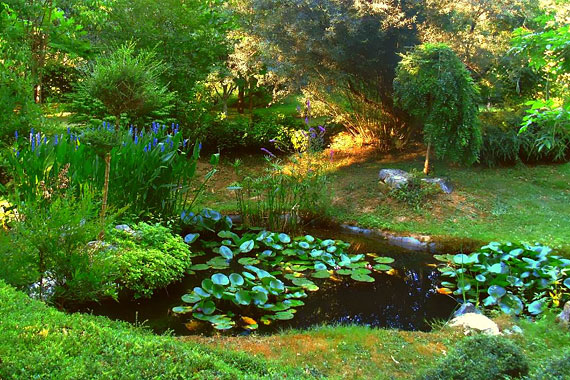
In Brantôme en Périgord you will find the Jardins Tranquilles, which are the result of one man’s passion: Jean-Pierre Texier. Born in a neighbouring village in the 1930s, this man was passionate and loquacious when it came to talking about his plants.
His love of nature can be seen everywhere in the gardens. As well as the great floristic diversity, the gardens are dotted with fountains, statues and several other hidden secrets.
Prehistoric man – a user guide
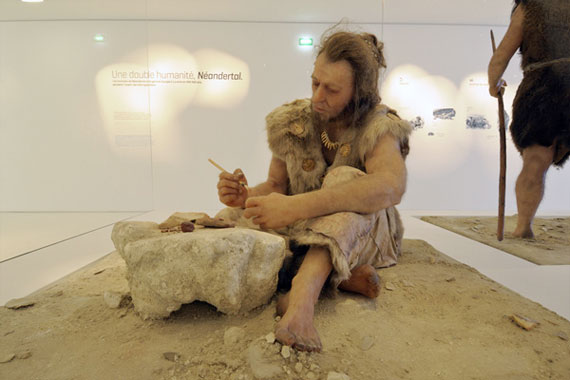
In order to understand prehistoric times, the caves and the men who lived during this era in the Périgord, we suggest you visit the Pôle International de la Préhistoire centre and its 3,000m² of free exhibitions.
Find out more...
Pôle International de la Préhistoire
Located in the heart of the Vézère valley, between Périgueux and Sarlat, the PIP welcomes you at the edge of the village of Les Eyzies. This valley, which has been occupied by man for 400,000 years, is the ideal place to understand prehistoric times. The 3,000m² of free exhibitions are accessible to all (exhibitions, workshops and educational tours, multimedia library, internet area, films and documentaries, conferences and shows).
Leisure activities
Brantôme and its surrounding area offer a wide variety of activities for the whole family. Just outside our campsite in the Dordogne you will find canoes or paddleboats for hire, a treetop adventure course, boat trips around Brantôme and, of course, all of the forest trails and lanes to guide you on your walks or bike rides.
Treetop adventure course,
the Périgord Vert from the treetops
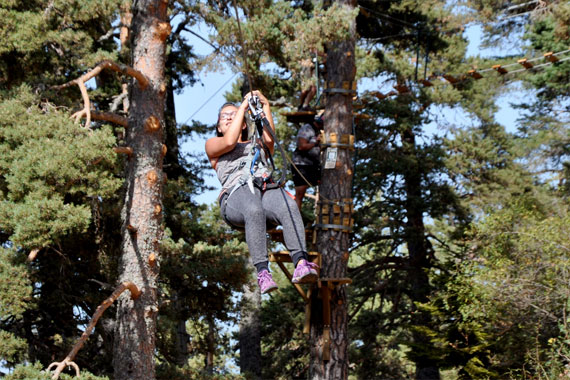
We suggest an outing, with your family or with friends, to the Cornille Aventure leisure park, where you can climb trees, play mini-golf or take part in a laser game in a 22 hectare park with a stunning view of the Périgord Vert.
Find out more...
Cornille Aventure
Come and enjoy the Cornille Aventure leisure park for a memorable day with your family or among friends. The park is located in a natural wooded and hilly setting in the heart of the Dordogne, 10 minutes from the centre of Périgueux.
Cornille Aventure offers a number of treetop acrobatic trails, a landscaped 18-hole mini-golf and an outdoor laser game.
The river Dronne
Make the most of our region’s sunny climate and go and sail on the river Dronne. You can choose where you want to set off from – those who come with their boats can leave directly from our campsite’s wooden pontoon – and go towards Brantôme and, why not, Bourdeilles. If you don’t have any equipment, go and see our partner Brantôme Canoë which is just a short walk from the campsite.
Find out more...
Brantôme Canoë
You can use your own boat straight from our campsite in the Dordogne, or go and see Brantôme Canoë who offer trips on the water, by canoe or paddleboat. It is an opportunity for the whole family to have fun together and to cool off in the Périgord sunshine.
Along the river
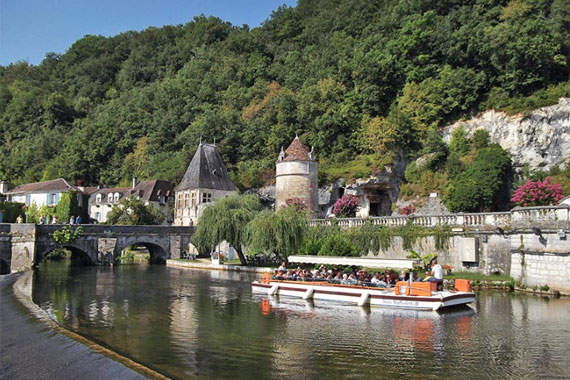
For those who prefer to be driven, go on a trip with Les Croisières de Brantôme. They offer trips on electric boats on the Dronne, and it is the chance to see our town from a different angle, accompanied by the helmsman’s interesting commentary.
Find out more...
Les Croisières de Brantôme
Go and explore Brantôme and its exceptional historical heritage on board the ‘Drona’, a 49-seater electric boat. As you sail along the waters of the river Dronne, the 50-minute guided cruise will let you discover Brantôme:
the 16th-century Pont Coudé bridge, the medieval and Renaissance style houses, the Benedictine abbey, the bell tower dating back to the 11th century, the troglodyte dwellings, the ‘monks’ garden’ with its 16th-century altars, the millers’ ford, the convent mill and small natural islands, etc.
Hikes and bike rides
Come and see us at reception, where we always have a map to plan your excursions – whether you are discovering the Dordogne on foot or by bike. Inviting pathways await you as soon as you come out of the campsite.
Find out more...
The Périgord Vert is a fantastic destination for hikers and cyclists (road and mountain bikes) and there are over a thousand kilometres of tracks across the Dordogne to take you even further in your discovery of the region, for example: the Camino de Santiago pilgrim trails, Périgueux’s ‘Green Way’ path, and the famous GR36 hiking trail.
Original and quirky visits
Our Dordogne-Périgord region is also full of original and quirky ideas for your stay.
Outings with your family or friends, so that you can make great memories and experience special moments.
Visit on the tracks
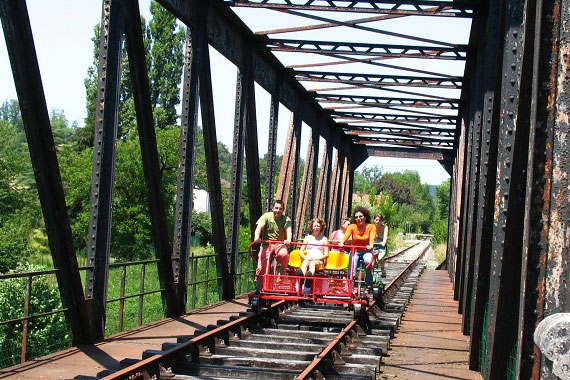
A great idea for an outing on old railway lines, Le VéloRail will guide you to the heart of the Dordogne towards magnificent landscapes – the Dordogne as you’ve never seen it before.
Find out more...
Le Vélorail in the Périgord Vert
During your stay at the campsite, go and explore the Dordogne with your family or friends with a ride on a pedal train (‘vélorail’) lasting approximately 2 hours. An 11km return trip on a former railway line that is full of charm, between small valleys and waterways, with its bridges, viaducts, tunnels and stations of old.
It’s uphill on the way out, and downhill on the way back. Two other routes are also available: 14km and 28km. Refreshments and facilities are available at Thiviers and Chatignolles stations (on certain days you can have a picnic there).
Electrical assistance is also possible.
Horse lovers
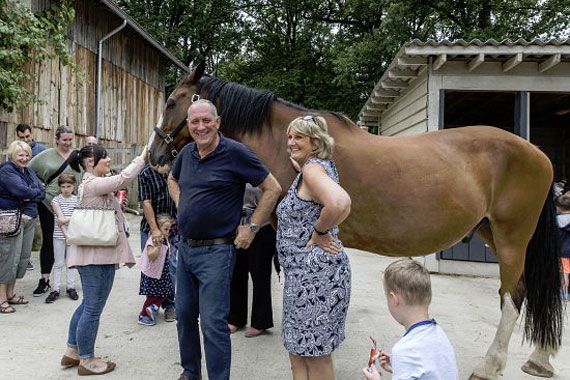
For several years now, the owners of this ranch have been providing a home for retired British police horses. You will be captivated by the rural setting as well as its magnificent animals, who are taking a well-earned rest at Brantôme Police Horses & Friends.
Find out more...
Brantome Police Horses & Friends
Just a few kilometres from the campsite is a retirement home of a different kind. Indeed, for several years now the English owners have been providing somewhere for the horses of the British mounted police to rest after their very busy careers.
A veritable ranch was built in the Dordogne as a result – it is an opportunity to have a cup of tea in a wonderful setting whilst the children go to see the donkeys and horses.
The Dordogne at the start of the latest century
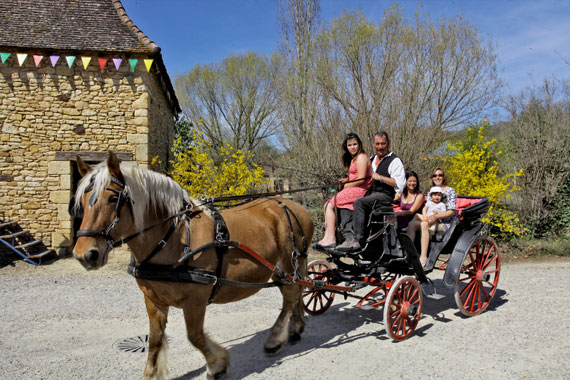
With its many carousels and attractions, the Parc Le Bournat theme park will take you back to 1900. Spend a day discovering old carousels and the ancient crafts of the Périgord.
Find out more...
Parc Le Bournat
Spend a day in a unique theme park that will take you back to 1900. Set in a 8 hectare park, a rebuilt village immerses you in the Belle Époque, where traditions, trades and skills reconstruct the Périgord way of life of yesteryear.
Around the various carousels you will discover the trades of times gone by – millers, cutlers and potters. You will be able to take part in quill writing, wood carving and wheat weaving workshops.
Enjoy the attractions, take a ride in a horse-drawn carriage, go on a boat trip or sign up for the quill writing workshops… unless of course you prefer to delight your children with the little animals, the free carousels or the 1900 big wheel!
We strongly recommend you visit on a Wednesday during the summer when there are evening events.
